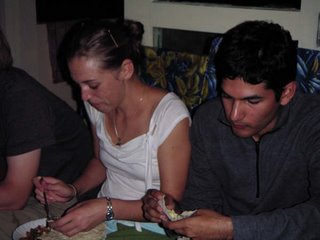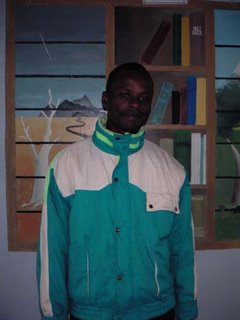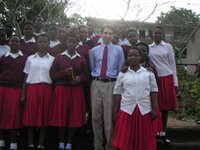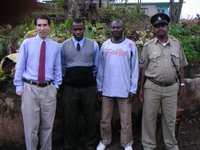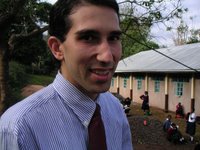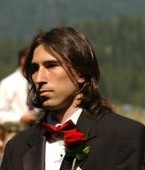
It's been a long time since I have written, and maybe a few of you worried that I fell of a cliff. But I didn’t fall, I flew. A few weeks ago I took a trip down to Victoria Falls in Zambia. Its roughly twice as wide and twice as tall as Niagara falls and is one of the seven natural wonders of the world. As the people that to travel to Africa tend to be adventurous there are numerous risky ways to make the falls more memorable. You can bungee jump off a bridge, canoe near the edge, raft the river bellow or fly above the falls. Suspiciously all the activities cost the same price: just under a hundred dollars with pictures for $15-$20 more. Having made the long journey down I felt obligated to do one of the activities. Although Louis jumped off the bridge, I chose not to make the leap of faith. Instead I viewed the falls from above with a micro flight.
A micro flight is motorized hang glider, or alternatively a motor cycle that flies. The experience of flying not as freeing as I expected. Somehow mentally pictured being like a bird gliding with the wind and being able to go anywhere you pleased. The reality is that you are padded up and piloted around on a basically fixed route. The view was spectacular and you can see lines where in 1000 years the falls will be and you gain a much better geological understanding of the area. I went through a lot to get to the falls and spent about three months of Peace Corps pay and came out about even and it was certainly memorable.
What it took to get there:
Food deprivation, sleep deprivation, and loud noises are just a few of the ways terrorists are possibly tortured during an interrogation. On my trip to see Victoria Falls I unwittingly subjected myself to this torture. To save money we avoided planes, and to save time we avoided trains, thus bus was the means of transportation from here to Livingston, Zambia. The first leg of the journey, from Moshi to Mbeya, took 16 hours. Since the food available at the bus rest stops is limited, my food for the day consisted of water and French fries and six mini muffins. The next day we got up early to catch the first available bus. After taking the three hour minibus to the border we paid for our visa and bus to Lusaka. Unfortunately, the costs for each of these was double what I expected, this is of significance because transportation was our major cost for the trip. Since our cash was now very limited and we found the earliest bus didn’t leave until 4PM, we filled the time by taking a taxi to the ATM in Mbeya and back. From Tunduma to Lusaka was 13 hours, where they played choir music videos and three low budget African films that had an inordinate amount of shouting. The entertainment and cold of the night combined to make an environment not conducive to sleeping. The bus stops were very short and infrequent so we didn’t eat or drink. This was partially by choice to reduce restroom necessities and partially because at night is difficult to see the people getting off the bus are doing (Is this their stop, or a food stop?). To add to the experience the aisle were filled 1-2 feet high with 90 lbs bags of grain and a drunk person got thrown off the bus for disturbing his neighbors. When we arrived in Lusaka it was 5 AM and everything was closed so everybody just stayed in the bus until around seven. We walked around and found a bakery to have breakfast then returned to the stand and caught a bus to Livingston. This was a pleasant six and a half hour ride and they served some refreshing mango juice. The return trip was about the same; Livingston to Lusaka a comfortable ride with mango juice (it really makes the trip),time for a meal in Lusaka, then board again. The ride from Lusaka to was about the same, replace the goods piled in the aisle with people, the noise with a window that won’t stay closed (wind noise + winter cold = no comfort), the drunkard with a fight between to guys over who gets a seat. There was a restful day in Mbeya followed by the long haul from Mbeya to Moshi.
Zambia Vs Tanzania:
Language:
The official language of Zambia is English and the average Zambian speaks it much better than the average Tanzanian. However, they do have regional Bantu languages and that seems to be what is commonly spoken. I could often understand fragments of what was being said around me but I could rarely follow the conversation.
Food:
I noticed that fruits were not as plentiful and there weren’t the fried chapatis or cakis at every corner. The replaced the cheap fried foods with more upscale pastries (éclairs, French twists, scones, etc.) easily found at bakeries and stores. There were more nice western chains like subway, and food court places. The standard fare cheap food is still ugali (called shima) with beans, and cooked greens. It was nice to see many more of the Western foods but near the end of the trip I was looking forward to some fruit.
Appearance:
The Zambians were noticeably thinner than the Tanzanians. I would not be surprised if the lack of cakis and chapatis has something to do with this. There were many more girls/women with pants, and very few women with loose fitting clothes. Since Tanzanian boys/men typically wear western style clothes there was not much difference in how they dress in Zambia.
Labels: Peace Corps Tanzania, Victoria Falls
 There are several weeks till I am home but tomorrow I enter my last week at site. Already leaving is not as easy as I thought it would be. The increase of visitors and requests for gifts was expected; this is both enjoyable and aggravating. Some are sincere in their interest and others are just looking for gifts. It's fun to be with friends but I have difficulty with one teacher, who though we were amicable before suddenly wants to be my best friend. I do like him but it is clear that whenever he comes over he is looking for something to take home. I don't really want to tell him off, but I also want the visits to change. On the plus side my house is slowly losing its clutter. I keep intending to do a practice pack, but I have a feeling it's just going to be a final pack.
There are several weeks till I am home but tomorrow I enter my last week at site. Already leaving is not as easy as I thought it would be. The increase of visitors and requests for gifts was expected; this is both enjoyable and aggravating. Some are sincere in their interest and others are just looking for gifts. It's fun to be with friends but I have difficulty with one teacher, who though we were amicable before suddenly wants to be my best friend. I do like him but it is clear that whenever he comes over he is looking for something to take home. I don't really want to tell him off, but I also want the visits to change. On the plus side my house is slowly losing its clutter. I keep intending to do a practice pack, but I have a feeling it's just going to be a final pack.
 Today is
Today is 






















